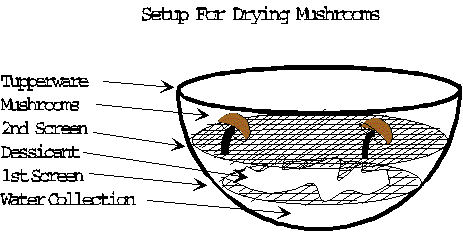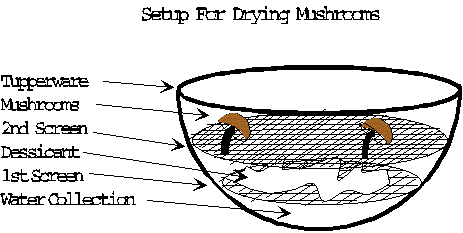 Drying and Preservation
Drying and Preservation
of the Mushrooms
Once you have grown and harvested some mushrooms, you need to think about preserving them. They will only keep for a short time in their fresh state. Sometimes a single mushroom needs to be harvested and it isn’t enough for a dose. Other times, too many mushrooms will be fully grown for a single dose. Either way, you will be in a situation where you want to preserve them for later. And, even if this didn’t happen, you may find your self in a situation where you simply don’t have the time or inclination to trip. The good news is that if they are dried correctly, nearly all of the psycho-active compounds can be preserved for many months.
There are several ways to dry them, but we will only cover the best way. What ever you do, don’t use heat to dry them. Heat is very harmful to the psycho-active compounds. You will drastically reduce the mushroom’s potency if you use heat to dry them.
Materials needed:
- 1/4 inch wire mesh
- old wash cloth or rag
- carton of Damp-Rid or Damp-be-Gone (Anhydrous calcium chloride)
- Medium or Large size Tupperware bowl with sealing lid
Several pounds of calcium chloride can be purchased for a couple of dollars at any large building supply outlet. It will usually be found in the paint department because it is used to dry the air in musty closets before painting and things like that. If possible, get the bulk refill containers. It will be cheaper than the calcium chloride that comes with the units to hold it and the moisture pulled from the air. You won’t be using the unit, so don’t buy it unless you have to.
The drying chamber needs to have a space at the bottom for water to collect. This allows the calcium chloride to function well for extended periods of time. As it pulls moisture from the air, it drips to the bottom of the chamber. The calcium chloride is held above the water by a circular section of the 1/4 inch wire mesh with a wash cloth spread out on it. See the following diagram for details. The wash cloth keeps the calcium chloride from falling through the wire mesh but any water that forms can drip through it to the bottom of the chamber.
The calcium chloride should be spread out evenly. If you use too large of a Tupperware bowl, you may have to add some structural strength to the screen in order for it to support the calcium chloride. You can simply lay a stick or ruler underneath the mesh and use tie wraps to secure the mesh to it.
Cut another circular section of mesh so that it fits above the calcium chloride and leaves a nice air gap. The mushrooms will be placed on this mesh in order to dry them. Make sure the calcium chloride is not touching the bottom of this screen. There should be an air gap between the top of the desiccant and the bottom of the screen. You do not want your mushrooms to touch the calcium chloride while they are drying because some of it will dissolve into the mushroom if this happens.
That is the entire preparation for preserving your mushrooms with minimal loss of potency. In order to dry your mushrooms, simply harvest them and place them on the wire screen. Close the Tupperware container so it is air tight. The mushrooms will shrink and shrivel over the next couple of days. After about three days, they will be fairly hard and contain very little moisture. If you are not pushed for space inside the drying chamber, you may was well leave them there for five or six days to thoroughly dry them.
After the mushrooms have been in the drying chamber for three days, they can be moved to a zip-lock bag for long term storage. Remember that the dryer the mushrooms are, the longer they will keep.
The reason this system works so well to dry the mushrooms is the calcium chloride is a good desiccant. It has a very strong affinity for moisture and can pull almost all the moisture out of the air. Eventually however, liquid will start to collect in the bottom of the drying chamber. Mushrooms are 92% water by weight. This moisture has to go somewhere when the mushrooms are dried, and it will eventually find its way to the bottom of the container.
When moisture starts to collect in the drying chamber you can simply drain it out and continue to use the old desiccant. The chamber will continue to work as long as there is sufficient calcium chloride in it. You should be careful not to contaminate the sides of the container or the top screen with residue from the desiccant. You do not want your mushrooms to touch the residue. For one thing, it tastes terrible, but in addition to this, the mushrooms will not dry completely. The residue will attract moisture. Whenever you empty the moisture, it is best to wash the Tupperware container completely.
